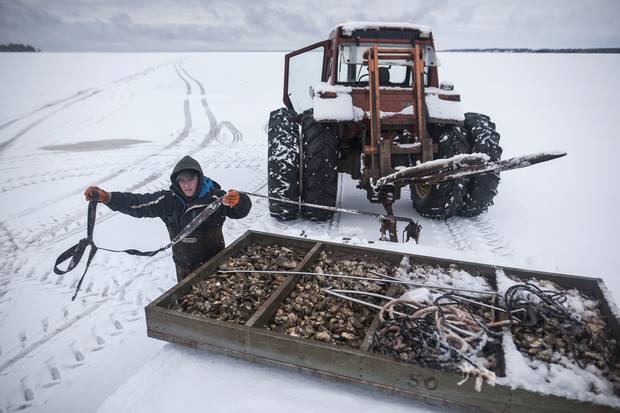"Has anybody not fallen through?" says oyster farmer James Power, as he stands on 15 centimetres of ice in the middle of New London Bay, off the coast of Prince Edward Island.
Mr. Power's question raises chuckles from his farmhands as they remember their own mishaps on the ice.
"You swim to the edge. It's actually quite easy," says Mr. Power, manager of Raspberry Point Oysters. "We've had people fall in who actually don't even get wet they're out so quick. Nine out of the 10 times that I fall in, it's one leg and no one sees it. It's more embarrassing than anything."
On this December day, the sky is thick with clouds and PEI's winter oyster harvest in the Gulf of St. Lawrence is in full swing. Hundreds of bays and coves that notch the island's coastline are covered with ice, creating giant coolers for the prized treasure beneath.
Oyster farmers start when the ice is thick enough, carving holes in it with chainsaws before diving in to haul the oysters over the ice – all to meet the demand for PEI's world-renowned oysters in wintertime, when they're at their plumpest and sweetest.
In recent years, the province's oyster industry has exploded, jumping in value from about $6.3-million in 2000 to $12.8-million in 2015. Last year, PEI produced 3,422 tonnes of farmed oysters, according to Statistics Canada, and this year, the province says it topped that with the biggest catch in history. (About 30 per cent of farmed oysters produced in Canada are grown on PEI, with the bulk of them going to wholesalers in Quebec and Ontario.)
Roughly 1,000 oyster fishers and aquaculturists work in the industry, either harvesting from public fishing grounds or raising oysters, a practice the province started in 1865 when it first began leasing parts of the ocean to grow oysters on the seabed. (It's now a federal responsibility.) Since the 1990s, oyster aquaculturists also began growing oysters suspended in the water in bags or trays. Today, PEI has 820 oyster culture sites that account for a total of 2,952 hectares of leased ocean.
During the holiday season, when people all over the world slurp them with Champagne or Chablis at parties and restaurants, the demand is high – second only to March and April when oysters aren't as readily available in other markets.
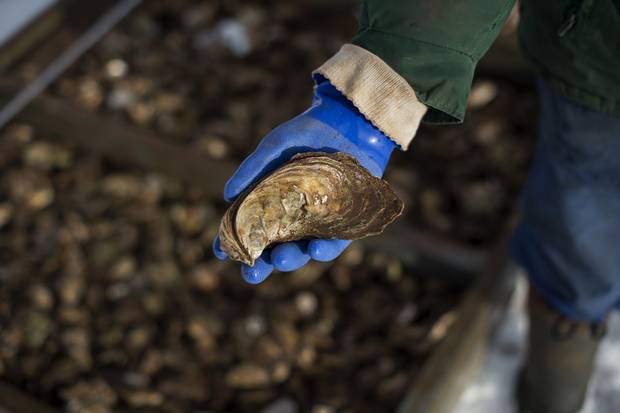
An oyster, estimated to be eight years old. Thirty per cent of Canadian-produced farmed oysters are grown on PEI.
Raspberry Point Oysters, which harvests eight million farmed oysters a year, is pulling out all the stops to meet the holiday rush. But cold weather means harvesting isn't all that straightforward.
Before ice forms over New London Bay, it looks like a giant pincushion with 850 metal poles sticking up. Each one marks the site of an oyster cage, weighing nearly one tonne and packed with 7,200 oysters. As the bay freezes and the tide heaves the ice, many of those poles fall over and the cages need to be relocated by a diver.
This morning, it's Richard McGraw making the feet-first plunge into the inky Atlantic with a rope around his wrist.
"At first it's a shock on your face, but then it goes a little numb and as the day goes on, it will swell up, almost like you're frozen at the dentist," says Mr. Power.
Mr. Power is on guard over the triangle-shaped hole in the ice. The tether is usually around 45 metres, but just to be safe today, it's not as long.
Five tugs on the rope mean, "Get me in quick." One tug means, "Give me some slack." Two tugs is, "I'm heading in." And three is, "Jackpot." (There isn't a four-tug signal for oyster diving because they want a clear distinction between "Found a cage" and an emergency.) After the diver finds a cage, he ties a knot in the rope, so when he comes up, they can use length of the rope to locate the cage from above.
An A-frame hydraulic lift pulls the oysters out of the ice and they're towed on a sled behind a four-wheeler or, if the ice is thick enough, a truck. On ice too thin for a four-wheeler, a diver has to swim up 72 seven-kilogram trays, two at a time.
The PEI oyster became famous at the 1900 Paris World's Fair when oysters from Malpeque Bay were declared the most delicious in the world. But in 1915, hard luck befell the industry when the majority of oysters on the island died of disease. The few that lived were in Malpeque Bay, and it was those oysters that were used to seed the rest of the island. This is why all oysters from PEI are considered Malpeque oysters.
What differentiates the PEI oyster is a clean, salty taste that finishes sweet – a combo unique to the Gulf of Saint Lawrence – and it becomes arguably even more succulent when the temperature drops. That's because as the ocean cools, the oyster's adductor muscle, which holds the shell together, grows stronger, adding a little bit of sweetness to the taste.
The oyster is also at its plumpest right when the cold weather hits, having filtered up to 189 litres of water a day while feeding on plankton until the waters drops to four degrees Celsius. Over the winter, the oyster lies dormant until spring – unless it's shucked and eaten first.
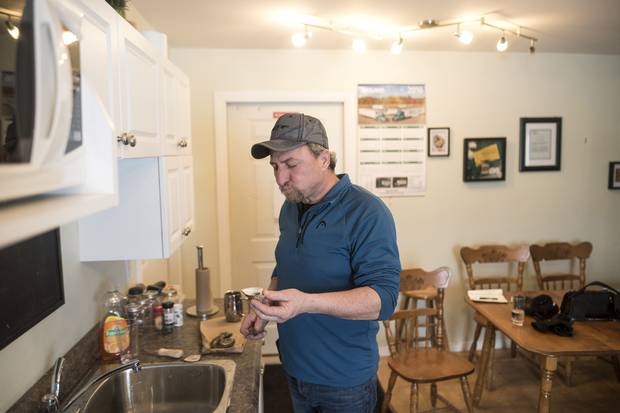
Brian Lewis snacks on Rocky Shore oysters after the holiday oyster harvest at Future Seafood Inc.
On the other side of the island, not far from Confederation Bridge, brothers Brian and Erskine Lewis of Future Seafoods fortify themselves for the last catch before Christmas. The men shuck and eat oysters like potato chips at the Formica counter in the kitchen/boardroom at the company they've run for 36 years in Bedeque.
"Look at that fella – the meat! – it's like a steak," says Brian Lewis, slurping it back and taking a swig of coffee. "You live to be 100 on those."
The week before Christmas, the brothers harvested an estimated 125,000 oysters. Brian stood waist deep in the marshy cove during a blizzard, hoicking nearly a half-tonne tray of oysters onto the ice as chilly seawater spilled over the top of his rubber coveralls.
"It's crazy. In your wildest dreams you'll not keep up to the demand right now. You sell every oyster you got," he says.
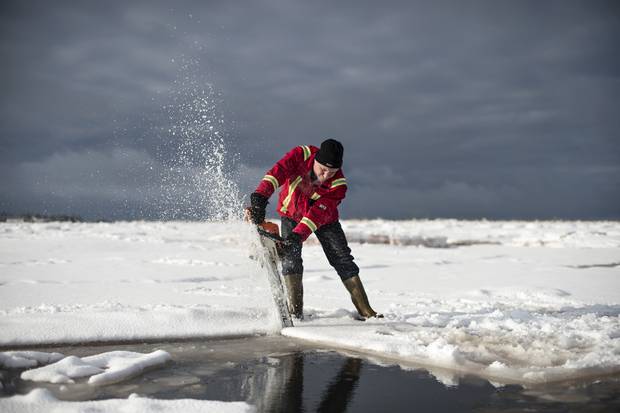
Brian Lewis, co-owner of Future Seafood, cuts through the ice with a chainsaw to look for their oyster trays on Salutation Cove.
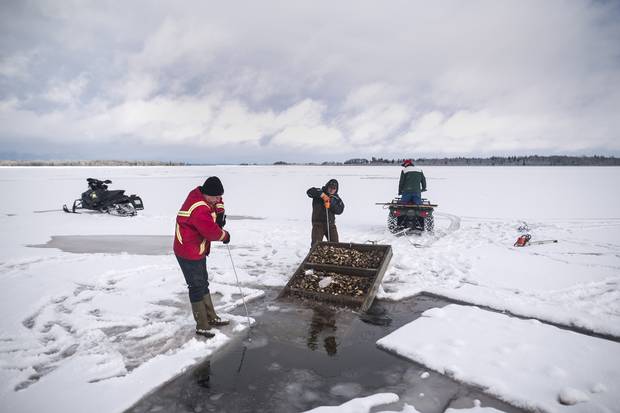
Brian Lewis, left, and Jason Boyles, middle, guide the tray of oysters as Erskine Lewis pulls with the four-wheeler.
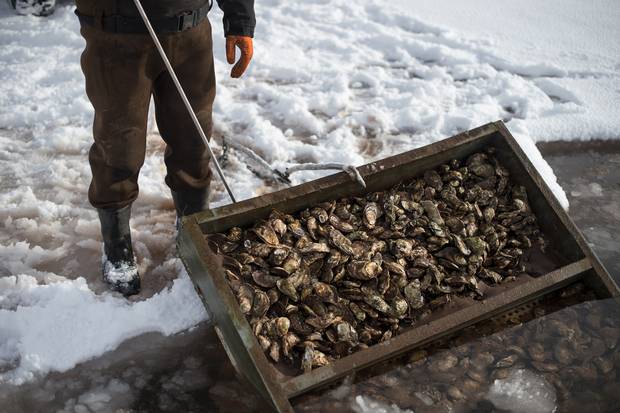
The men were supposed to harvest more, but some trays get temporarily lost under the ice. They’ll find them again in the spring.
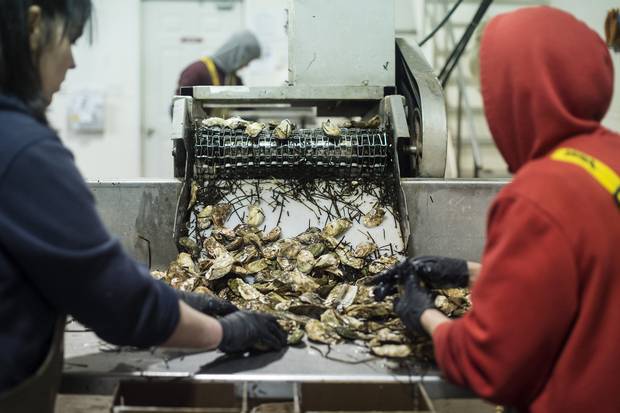
Employees clean and sort oysters at the processing plant at Future Seafood Inc. in Fernwood, PEI.
An oyster man since age 12, Brian used to harvest all winter long and dive under the ice, but the cost and risk became too high for his family-run business. These days, he heads to Florida in a motorhome after the holiday rush.
On this day, the weather is more co-operative; it's bright and mild.
It's low tide now as the brothers head onto the frozen cove: Erskine's on the four-wheeler with a sled, Brian is on the Ski-Doo.
There were supposed to harvest more, but like at Raspberry Point, some trays were temporarily lost under the ice. But the men aren't fazed; they'll find them in the spring.
They carve a hole in the ice with a chainsaw and there lies the prize: 4,000 grey, emerald and ecru-coloured mollusks submerged on the shallow seafloor. The brothers attach a hook from the back of the four-wheeler and haul up the wooden tray, capturing crabs, the rust-coloured mud and seaweed as it slides onto the sled.
"It's invigorating," says Brian. "You get fresh air, sunshine and you're making money."
MORE FROM THE GLOBE AND MAIL
